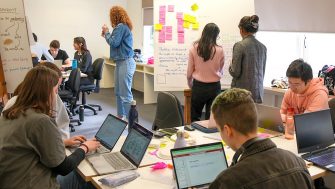Creating a collaboration culture: three principles for organisations looking to unlock innovation
The need for truly innovative ideas has never been more pressing.
The need for truly innovative ideas has never been more pressing.

In a complex and fast-paced world, innovation isn’t an advantage; it’s a necessity. As industries, governments, and communities grapple with challenges in an ever-changing environment, the need for truly innovative ideas has never been more pressing.
How can organisations design the creative, collaborative and inclusive conditions required for innovation to flourish amid these challenges? Here are three principles we have learnt from our work over three years at the Innovation Hub at UNSW Arts, Design & Architecture to help empower your teams and spark your next breakthrough.
Build your teams around diversity – diversity of disciplines, diversity of representation and diversity of lived experience. The nature of the problems we need to solve can’t be viewed through a single discipline or one person’s perspective. They require a mix of voices ready to challenge each other in order to fully understand the issues and unlock unique solutions.
Over the past three years, we’ve seen first-hand how bringing together people from different contexts, ages, fields, experiences, and perspectives can lead to breakthroughs. We have worked with over 260 staff members, 110 students and 20 partners - all bringing unique and deep insights that have enriched 19 design-led projects. In each case, diversity has contributed to the discovery and depth of innovative solutions.
Diversity through invitation doesn’t instantly create and promote inclusion, however. It takes sincere effort to create a culture of respectful collaboration and support where diverse voices feel truly included to share and challenge. Often this means rejecting unnecessary and unproductive hierarchies and project structures to make way for more open and honest collaborative methods. Using a flat structure in project teams can support all voices being heard and all skills equally valued, getting you one step closer to a meaningful and innovative creative breakthrough.
Novel methods are an essential ingredient for arriving at unique solutions. Considering new ways to approach a problem, or strategising new paths for the problem-solving process can spark unexpected outcomes. This, combined with diverse knowledge, skills and experience is where we uncover new solutions.
Novel methods also infuse fun into the process, building an optimistic and creative problem-solving culture that encourages risk-taking and open minds. It’s about shaping an environment where collaboration is not just fruitful, but exciting, joyful, and open to evolution – as those who attended our Unconvention experienced.
Designing a novel problem-solving process can dismantle some of the barriers that traditional innovation and research processes perpetuate and fosters an environment where ideas can emerge from unexpected places. To do this, try incorporating team-building activities early in the process such as a design sprints and hackathons to promote a culture of critical thinking and healthy debate. Hosting these events outside of the standard working environment for the given team can also encourage more creative thinking.
For us, the Festival of Care project stands as a strong example of how embedding novel methods from ideation through to execution can yield both optimism and tangible impact. It’s through a spirit of purposeful, optimistic, and creative problem solving that this project team arrived at a series of creative arts-based health interventions that were brought to fruition across four hospital sites, improving the well-being of hundreds of hardworking hospital staff.
For a project to move beyond an innovative idea to being successfully implemented for impact, a profound commitment to care should lie at the core. This means not only the empathy we extend to the communities, customers or clients we serve but also the support we provide to our colleagues that propels them to find solutions that are not just fit for purpose but compassionate and value all life on earth.
Deep listening and open communication are two ways to create a culture of care, both internally to the project, and with project partners. For deep listening, allowing each participant to not only speak but have the time required to be truly understood and responded to constructively, demonstrates understanding. Maintaining open communication by encouraging feedback, promoting a nonjudgmental atmosphere, recognising and appreciating contributions, and celebrating small wins also go a long way.
Another way we create a culture of care in our project teams is by using an opt-in model, allowing project team participants who care deeply about the problem at hand to thrive. The ‘Caring for Country Leave’ initiative, developed during Massive Action Sydney, is an excellent example of innovation that was born from the dedication of value-aligned participants. The solution proposed by the project team also embodies care, by asking us to change our mindset from what we can get to what we can give through caring for and honouring the land in a new category of workplace leave.
There is no magic formula for innovation, but we have found that diversity, novel methods, and a culture of care are three of the key ingredients that create the environment required for meaningful innovation to flourish.
These are more than just principles – they are practices ingrained within the way we work and partner with others to create a world that’s smarter, kinder, and more inclusive.
If you would like to know more about our approach or work with us, please reach out.